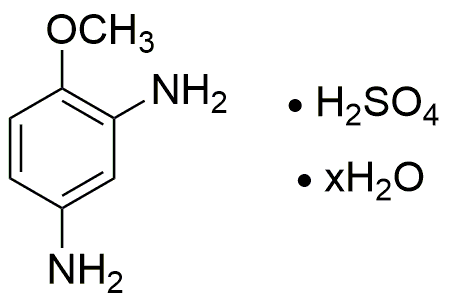2,4-Diaminoanisole sulfate hydrate is widely utilized in research focused on:
- Dye Manufacturing: This compound serves as a key intermediate in the production of azo dyes, which are widely used in textiles and printing. Its ability to form vibrant colors makes it essential for the fashion and design industries.
- Pharmaceuticals: It is employed in the synthesis of various pharmaceutical compounds, particularly in the development of medications targeting skin conditions, due to its properties that can enhance skin penetration.
- Cosmetics: The compound is used in cosmetic formulations, especially in hair dyes, where it contributes to color stability and intensity, appealing to consumers seeking long-lasting results.
- Research Applications: In laboratories, it is utilized as a reagent in organic synthesis and analytical chemistry, aiding researchers in developing new compounds and conducting experiments efficiently.
- Environmental Studies: The compound is also studied for its potential effects on the environment, particularly in assessing the impact of dyes and chemicals in water systems, helping industries comply with environmental regulations.
General Information
Properties
Safety and Regulations
Applications
2,4-Diaminoanisole sulfate hydrate is widely utilized in research focused on:
- Dye Manufacturing: This compound serves as a key intermediate in the production of azo dyes, which are widely used in textiles and printing. Its ability to form vibrant colors makes it essential for the fashion and design industries.
- Pharmaceuticals: It is employed in the synthesis of various pharmaceutical compounds, particularly in the development of medications targeting skin conditions, due to its properties that can enhance skin penetration.
- Cosmetics: The compound is used in cosmetic formulations, especially in hair dyes, where it contributes to color stability and intensity, appealing to consumers seeking long-lasting results.
- Research Applications: In laboratories, it is utilized as a reagent in organic synthesis and analytical chemistry, aiding researchers in developing new compounds and conducting experiments efficiently.
- Environmental Studies: The compound is also studied for its potential effects on the environment, particularly in assessing the impact of dyes and chemicals in water systems, helping industries comply with environmental regulations.
Documents
Safety Data Sheets (SDS)
The SDS provides comprehensive safety information on handling, storage, and disposal of the product.
Product Specification (PS)
The PS provides a comprehensive breakdown of the product’s properties, including chemical composition, physical state, purity, and storage requirements. It also details acceptable quality ranges and the product's intended applications.
Certificates of Analysis (COA)
Search for Certificates of Analysis (COA) by entering the products Lot Number. Lot and Batch Numbers can be found on a product’s label following the words ‘Lot’ or ‘Batch’.
*Catalog Number
*Lot Number
Certificates Of Origin (COO)
This COO confirms the country where the product was manufactured, and also details the materials and components used in it and whether it is derived from natural, synthetic, or other specific sources. This certificate may be required for customs, trade, and regulatory compliance.
*Catalog Number
*Lot Number
Safety Data Sheets (SDS)
The SDS provides comprehensive safety information on handling, storage, and disposal of the product.
DownloadProduct Specification (PS)
The PS provides a comprehensive breakdown of the product’s properties, including chemical composition, physical state, purity, and storage requirements. It also details acceptable quality ranges and the product's intended applications.
DownloadCertificates of Analysis (COA)
Search for Certificates of Analysis (COA) by entering the products Lot Number. Lot and Batch Numbers can be found on a product’s label following the words ‘Lot’ or ‘Batch’.
*Catalog Number
*Lot Number
Certificates Of Origin (COO)
This COO confirms the country where the product was manufactured, and also details the materials and components used in it and whether it is derived from natural, synthetic, or other specific sources. This certificate may be required for customs, trade, and regulatory compliance.


